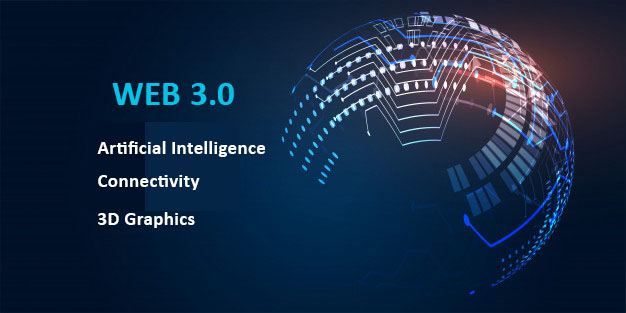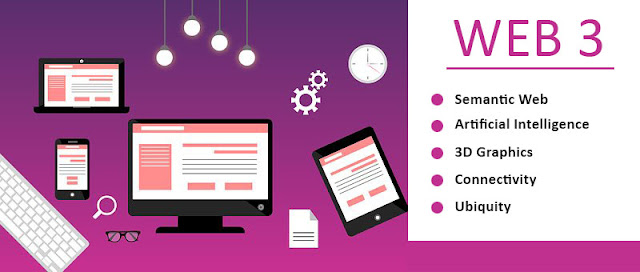Web 3.0 Basics
Web 3.0 is going to be a complete reinvention of the web, a thing that Web 2.0 was not. Web 2.0 changed this by allowing user interaction with dynamic sites that acted more as applications compared to simply pages of data. Web 3.0 is slated to be the new paradigm in web interaction and will indicate a fundamental shift in how developers create sites, but more importantly, how folks interact with those websites. Computer scientists and Web experts think that this new paradigm in web interaction will further make people's online lives easier and more intuitive as smarter applications like better search functions provide users exactly what they are searching for, because it'll be similar to an artificial intelligence that understands context rather than simply comparing key words, as is now the case.
What's more, if someone is preparing for a holiday and should look for cheap flights and accommodations in addition to meals, they need to look through a lot of information about the web comparing different selections and the search might take hours. But Internet 3.0 lookup engines or assistants will be able to scratch all this information and present it to the user in a very intelligent way, even creating highly precise and beneficial suggestions based on the user's profile. There's not any concrete definition for Web3.0 yet and the technology which will bring us there has not even matured yet. So to have a better knowledge of Internet 3.0, let's take a look at an example. In the current Web 2.0, users can interact with sites that have predetermined behaviours according to the input of users.
Users may search for information using various search engines that generally offer satisfactory results if there is enough information regarding the search. But that search is only for keywords and brings in the most popular information accessible, and does not understand the context of the search. If a user searches for a bug called a camaro and utilizes only that one word, then about 90% of the lookup results are to get the Chevy Camaro model of automobile and not the insect because the car has become the most popular search outcome and gets the most prolific info. However, Web 3.0 will be able to get the context from the user; and then be able to provide the user with the most useful information regarding the camaro insect, for example its habitat as well as where to find it as a delicacy. Web 3.0 can be likened to a artificial intelligence helper that understands its user and personalizes everything.
Now that we kind of have a vague notion of what Web 3.0 is, what exactly will it look like when it is here in full force? We'll experience a lot of change until it emerges. For example, not only will you have replaced the computer on your desk since it turned into way too slow, but you'll probably have replaced its replacement to exactly the same reason. In fact, the amount of all human knowledge may very well have dropped by the time we're well in Web3.0.
A lot of people believe that the very first signs of Internet 3.0 are already here. The fact remains that predicting the Web 3.0 future is a guessing game. A Is the reason the simple question of"What is Web 3.0" can get you heaps of unique replies. Of how we are utilizing the net now, a breakthrough in web technology, or But it took over ten years to make the transition out of the original web to Web 2.0, and it may take just as long (or even more ) for its next fundamental change to make its mark and totally reshape the web.
So, when we inquire what Web 3.0 could be, we must realize that One of the biggest problems in nailing down a definition or Web 3.0 is a simple term with a far more complex significance, which Most folks generally have some idea that Web 2.0 is an interactive and social web Metric for assessing Web 3.0 is the absence of a definite, distinct definition for this, especially compared to what we already know about Web2.0. Facilitating collaboration between people. This is distinct from the ancient, first state of this net (Web1.0) which was a static information dump where folks read sites but rarely interacted with them. Can derive an answer. Web3.0 is the upcoming fundamental change both in how sites are created and more importantly, how folks interact with them.Only a technological breakthrough generally.
When we distill the essence of change between Web 1.0 and Web 2.0, we now Fundamental change in the way we use the web could be determined by an evolution That became popular in 2004. If the upcoming fundamental change happened in roughly the exact same time period, we should have officially broken into Internet 3.0 sometime in 2020.
What's more, if someone is preparing for a holiday and should look for cheap flights and accommodations in addition to meals, they need to look through a lot of information about the web comparing different selections and the search might take hours. But Internet 3.0 lookup engines or assistants will be able to scratch all this information and present it to the user in a very intelligent way, even creating highly precise and beneficial suggestions based on the user's profile. There's not any concrete definition for Web3.0 yet and the technology which will bring us there has not even matured yet. So to have a better knowledge of Internet 3.0, let's take a look at an example. In the current Web 2.0, users can interact with sites that have predetermined behaviours according to the input of users.
Users may search for information using various search engines that generally offer satisfactory results if there is enough information regarding the search. But that search is only for keywords and brings in the most popular information accessible, and does not understand the context of the search. If a user searches for a bug called a camaro and utilizes only that one word, then about 90% of the lookup results are to get the Chevy Camaro model of automobile and not the insect because the car has become the most popular search outcome and gets the most prolific info. However, Web 3.0 will be able to get the context from the user; and then be able to provide the user with the most useful information regarding the camaro insect, for example its habitat as well as where to find it as a delicacy. Web 3.0 can be likened to a artificial intelligence helper that understands its user and personalizes everything.
Now that we kind of have a vague notion of what Web 3.0 is, what exactly will it look like when it is here in full force? We'll experience a lot of change until it emerges. For example, not only will you have replaced the computer on your desk since it turned into way too slow, but you'll probably have replaced its replacement to exactly the same reason. In fact, the amount of all human knowledge may very well have dropped by the time we're well in Web3.0.
A lot of people believe that the very first signs of Internet 3.0 are already here. The fact remains that predicting the Web 3.0 future is a guessing game. A Is the reason the simple question of"What is Web 3.0" can get you heaps of unique replies. Of how we are utilizing the net now, a breakthrough in web technology, or But it took over ten years to make the transition out of the original web to Web 2.0, and it may take just as long (or even more ) for its next fundamental change to make its mark and totally reshape the web.
So, when we inquire what Web 3.0 could be, we must realize that One of the biggest problems in nailing down a definition or Web 3.0 is a simple term with a far more complex significance, which Most folks generally have some idea that Web 2.0 is an interactive and social web Metric for assessing Web 3.0 is the absence of a definite, distinct definition for this, especially compared to what we already know about Web2.0. Facilitating collaboration between people. This is distinct from the ancient, first state of this net (Web1.0) which was a static information dump where folks read sites but rarely interacted with them. Can derive an answer. Web3.0 is the upcoming fundamental change both in how sites are created and more importantly, how folks interact with them.Only a technological breakthrough generally.
When we distill the essence of change between Web 1.0 and Web 2.0, we now Fundamental change in the way we use the web could be determined by an evolution That became popular in 2004. If the upcoming fundamental change happened in roughly the exact same time period, we should have officially broken into Internet 3.0 sometime in 2020.






Comments
Post a Comment